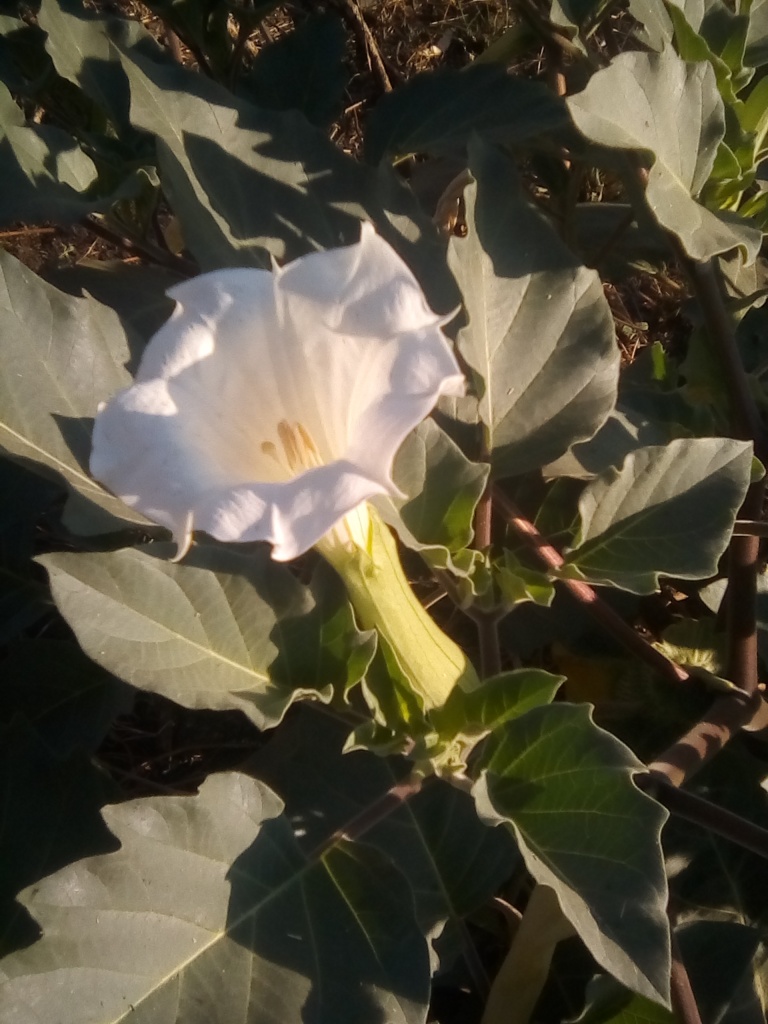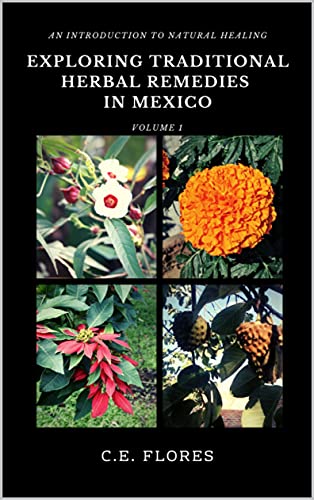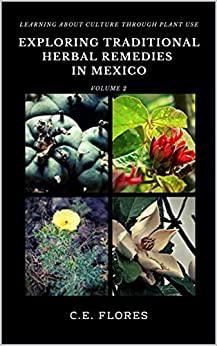The beginning of the rainy season in our normally dry area brings with it all sorts of flowering plants that not having grown up here I struggle to identify. Every year, directly in front of our house, a deep green plant with the most glorious white blossoms appears. And every year, some part of me screams “POISON STAY AWAY” at the most primitive level. This year, I decided to positively identify this plant to determine whether my inner plant scream was accurate. It’s not like I’m doing anything else lately.

Anyway, after trekking over to its location to get a few pictures, I leafed through my favorite herbal book Infusions of Healing by Joie Davidow and came across a picture of a similar plant with the botanical name Datura. Armed with this bit of knowledge, I took my search to google to positively identify the plant.
This plant that raises my danger hackles is either a Datura leichhardtii or Datura wrightii, which is also known as Datura meteloides, tolguacha, or Sacred Datura. The internet can get you only so far. Both are native to Mexico and fond of heat. They can grow into a bush that can get up to three feet tall. All parts of these plants are poisonous.
In English, varieties of the Datura species are known as thornapples, jimsonweed, Devil’s trumpets, moonflower, Devil’s weed and Hell’s Bells.

In Nahuatl, plants in this species were called Toloache, Tolova xihuitl, or Tolohuaxihuitl. Datura innoxia was Toloatzin (bended head) and Datura stramonium was Tlapatli (the plant with the nodding head). In Maya, plants of this species are known as Tohkú and Mehen-x-toh-ku.
Datura ceratocaula is a swamp dwelling plant known as Torna Loca (it makes you crazy). Datura arenicola is another variety native to desert areas in Baja California. Datura discolor is found in the Sonoran desert. Datura quercifolia is called Toloache hoja de encino (oak leaf plant) because of the shape of its leaves.
Interestingly, Datura metel is believed to be a result of pre-Colombian cultivation in the Carribbean that somehow traveled to India in the second century C.E. This makes it the oldest plant introduction from the New World to the Old World.
These deadly plants were used ritually and medicinally by the Aztecs. Priests ingested the plant to induce hallucinations they believed were from the gods. These altered states allowed the holy men to visit ancestors or foretell the future. Not surprisingly, ingesting the seeds and flowers causes respiratory depression, hallucinations, psychosis and arrhythmias.
Datura innoxia is still used as a visionary drug by the Mixtec and added to chicha (corn beer) or pulque (made from the maguey) to induce prophecies. Jugo de toloache is made from D. innoxia and sold as a love potion. Maya Shamans smoke chamal (cigars made from tobacco and dried D. innoxia leaves) to induce a trance.
Datura ferox is believed to be an incarnation of a deity to the Tarahumara and the Huichol. The Tarahumara add the seeds to tesgüino (corn beer).
The Tepehuanes believe toloache is the husband of the corn woman and son-in-law of the sun. Several indigenous groups once used this plant in rites of passage ceremonies and it is sometimes still used in brujería (witchcraft).

The Little Book of the Medicinal Herbs of the Indians records several medicinal uses. The leaves of the Tolova xihuitl variety were used to treat earaches and scrofulous tumors. Tolohua leaves crushed in egg yolk was a remedy for glandular swellings. Pain in the side was treated with Tolohua-xihuitl. Genital inflammations were treated with a heated poultice of a variety of herbs including tolohua-xihuitl. A salve was made for cracked feet from herbs, resin, the blood of a rooster, and tolohua-xihuitl. Lesions were also treated in a three part cure that ended with the application of ground up tolohua-xihuitl. Skin afflictions warranted an herbal wash that included tolohua-xihuitl.
Bernardino de Sahagún recorded that this plant was used to treat fever. The leaves were applied topically in an ointment to alleviate arthritis and sciatica pain and ground up seeds were used for gout. Flowers placed under the pillow were used to treat insomnia or induce a trance. On the other hand, he also wrote of it being used as a poison designed to harm enemies.
One remedy from Coahuila, calls for the toasted leaves of the Datura wrightii to be placed on sores. In other areas of Mexico, toloache tea is given to laboring mothers to help with the pain. Manteca (lard) and D. innoxia are used to treat joint pain. The Maya traditionally use the plant to treat rheumatism. Smoking the dried leaves is used to treat respiratory ailments.
Crushed leaves give out a bad smell. The morning blooming flowers are sweetly scented and are found in white, yellow, pink and pale purple. The plant adapts to its environment, making it sometimes difficult to identify. For example, in a perfect setting with adequate sun, shade and water, a plant can reach up to three feet high. However, in a dry area, the same variety might only reach ankle height with small flowers and leaves.
Although all Datura varieties are toxic, the level of toxicity of a given plant is dependent on the age and growing conditions. This variation makes it hard to determine ahead of time how much of the plant can be used safely for medicinal purposes. In fact, sometimes poisoning may result from eating honey that was made from Datura nectar.
Datura innoxia has the highest antioxidant levels of the species. Datura stramonium contains alkaloids, tannins, carbohydrates and proteins. Both varieties have antibacterial properties. All parts of the plant are anti-inflammatory and many also have antifungal properties. Extracts can be used to counter cypermethrin pesticide toxicity and organophosphate exposure because it contains atropine. It has also been shown to be effective in the treatment of gastrointestinal ailments and cholera.
Even though the Datura has been used medicinally for centuries, I don’t believe myself qualified to make any sort of concoction from any part of the plant in front of my house. However, I had a marvelous time running down all these interesting bits of information.
Do you have Datura in your area?
***
Interested in natural remedies? Uncover herbal remedies from traditional Mexican sources for healing and wellness in the Exploring Traditional Herbal Remedies in Mexico series.



